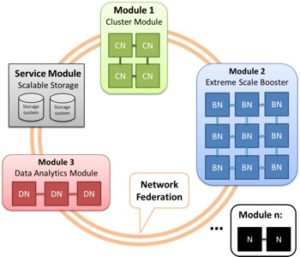
Design of the modular supercomputer architecture
The DEEP exascale research computing project has entered its next phase with launch of the DEEP-EST project at the Jülich Supercomputing Center in Germany.
Creating a modular supercomputer tailored to the complexity of state-of-the-art simulation codes and the growing range of tasks at computing centres – this is the aim of DEEP-EST, an EU project launched on 1 July 2017. The plan is to develop a prototype by 2020 that combines different computing modules according to the building-block principle. DEEP-EST is the successor project to the now successfully concluded DEEP and DEEP-ER projects and its plans include an additional new module suitable for applications managing large volumes of data. Sixteen leading international research institutions and companies are involved in the project, which is coordinated by Forschungszentrum Jülich.
For smartphones and laptops, it has long been more than simply computing power that counts: cameras, network interfaces, and GPS are just as important. A similar trend can be seen in the field of high-performance computing. In addition to compute-intensive simulations – the traditional tasks undertaken in scientific computing centers – new applications such as big data analytics and sophisticated visualizations are gaining importance – but current supercomputer architectures cannot handle these tasks efficiently.
The optimization of homogeneous systems has more or less reached its limit. We are gradually developing the prerequisites for a highly efficient modular supercomputing architecture which can be flexibly adapted to the various requirements of scientific applications,” explains Prof. Thomas Lippert, head of the Jülich Supercomputing Centre (JSC).
According to the Modular Supercomputing concept, accelerators and storage modules are no longer combined with individual CPUs using expansion cards but pooled into independent modules. Their units, called nodes, can be combined as needed. A flexibly adaptable system will be the end result, which will use pioneering technologies to form the basis for “exascale” computers: future supercomputers which will be more powerful by a whole order of magnitude than the fastest supercomputers today.
New module for big data
By 2020, a prototype is to be developed in DEEP-EST that should demonstrate the advantages of the concept. The project involves the introduction of a new data-analytics module to expand the Cluster–Booster architecture of the previous DEEP and DEEP-ER projects. Making use of large storage capacity and flexibly programmable processors, called FPGAs, the data-analytics module is set to close a gap resulting from the different hardware requirements for high-performance computing (HPC) and high-performance data analytics (HPDA).

Dr. Estela SuarezProject leader Dr. Estela Suarez, Jülich Supercomputing Centre (JSC)
For conventional supercomputing applications, such as simulations from quantum physics, an extremely large number of mathematical operations are applied to a relatively small set of data. This requires systems with a lot of computing power but relatively little storage,” explains Dr. Estela Suarez from the Jülich Supercomputing Centre (JSC). “But applications are becoming significantly more complex and the volumes of data from present-day experiments, for example at CERN, are increasing in size. This means that supercomputers will require drastically larger storage capacities – and they must be located as close to the processors as possible. Only then can the data be processed in a fast and energy-efficient manner,” explains Estela Suarez.
Applications determine development
A total of six applications from relevant European research fields are drawn upon for the co-design development of the prototype. The requirements of the codes will influence its design. At the same time, the codes will benefit from optimizations in the course of the project. For example, together with KU Leuven, the researchers aim to adapt a code used to simulate the effect that powerful solar storms have on the Earth. Although such events are rare, they threaten to cause enormous damage, such as a failure of satellite communications or disrupted GPS, internet, and telephone connections.
Tests will reveal to what extent highly complex space weather simulations will profit from the modular supercomputer architecture. Different parts of the complex scientific code are allocated to different modules for this purpose. The system software environment that will also be developed as part of the project will ensure the best possible distribution. A sophisticated resource management is also planned to ensure that the different components of the architecture are used as efficiently as possible at all times, thus saving energy.
In the case of space-weather simulations, for example, particularly the data-intensive analysis of high-resolution satellite images is ideal for outsourcing to the Data-Analytics module. In contrast, other parts of the simulation code – for example the interaction of particles emitted by the Sun with the Earth’s magnetic field – are distributed to the Cluster module, which has powerful general-purpose processors, and the Booster, which is based on interlinked, highly parallel multicore processors.



